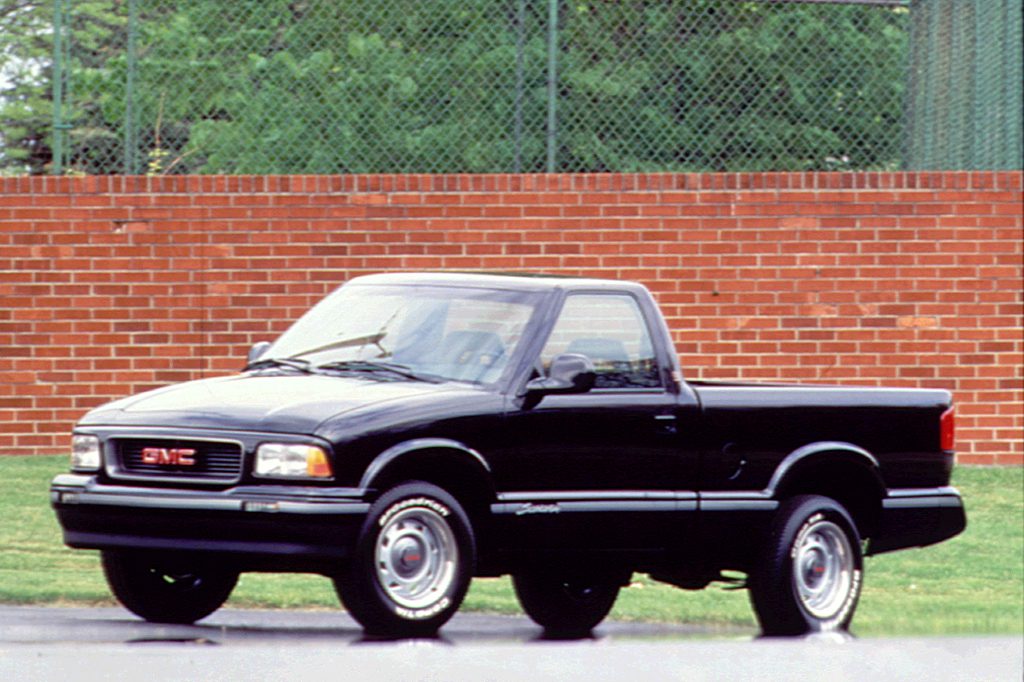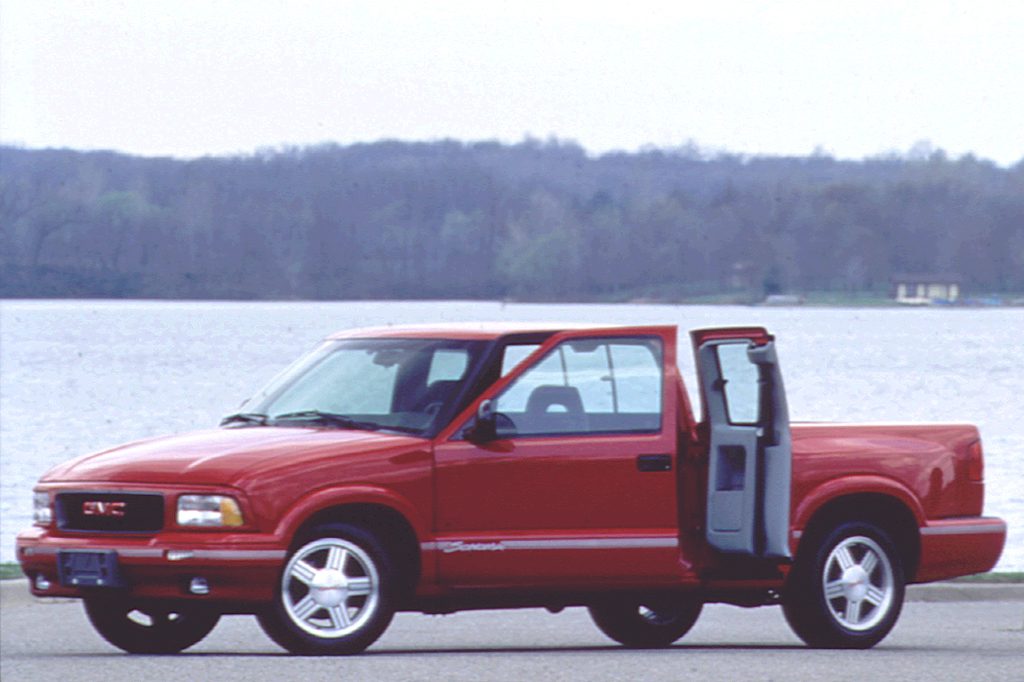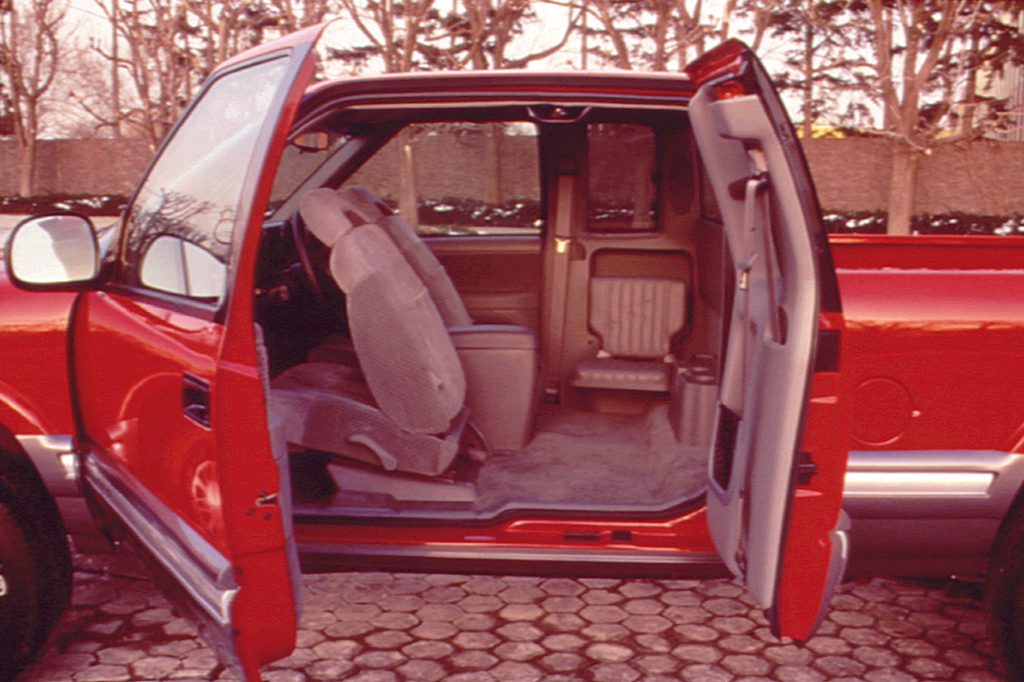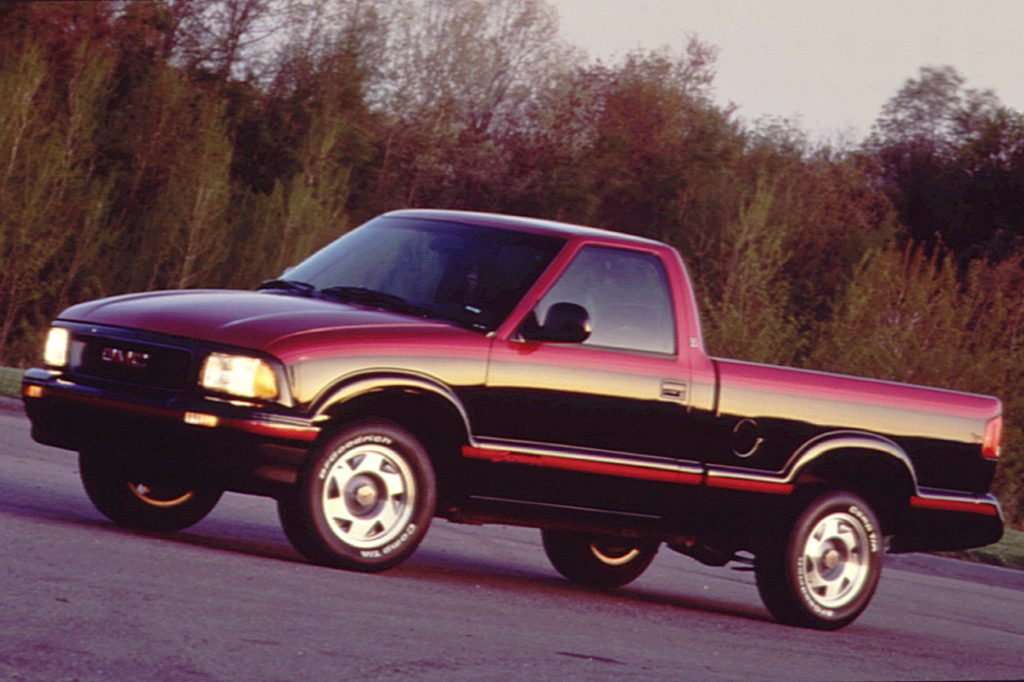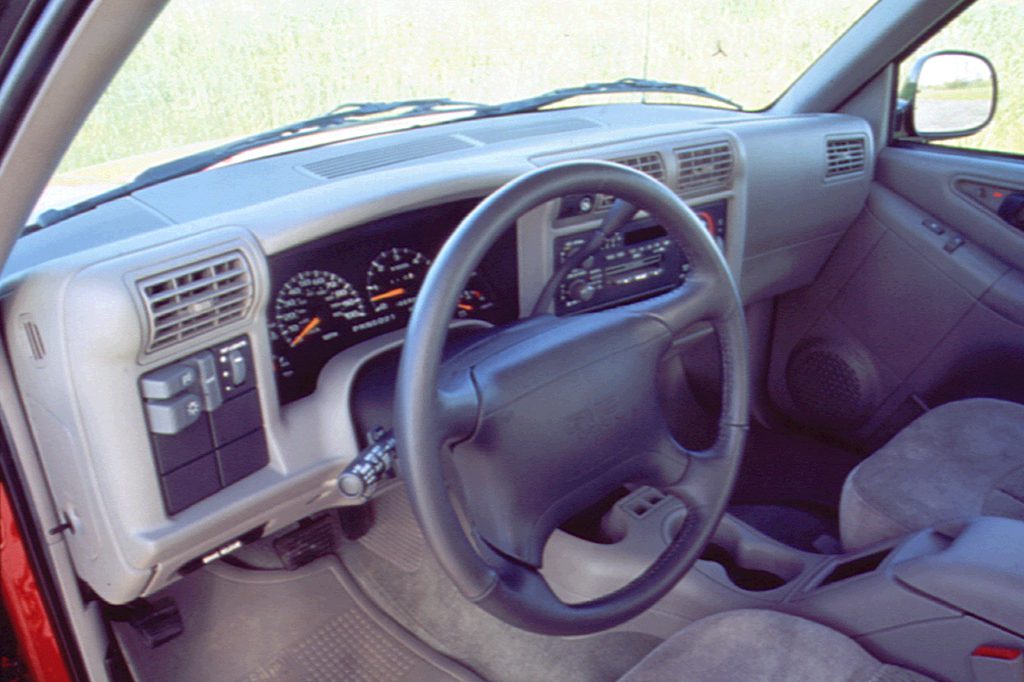| Standard Equipment |
| SL : 2.2-liter 4-cylinder engine, 5-speed manual transmission, dual front airbags, antilock brakes, daytime running lights, variable-assist power steering, vinyl or cloth bench seat (regular cab), split folding bench seat w/storage armrest (extended cab), rear jump seat (extended cab), cupholders, third door (extended cab), AM/FM radio, digital clock, passenger-side visor mirror, intermittent wipers, automatic headlights, black vinyl floor covering, theft-deterrent system, dual outside mirrors, painted front bumper and rear step bumper, Wideside bed, Smooth Ride Suspension Pkg. (regular cab short bed), Z85 Heavy Duty Suspension Pkg. (regular cab long bed, extended cab), 205/75R15 tires, 4WD models add: 4.3-liter V6 190-horsepower engine, 4-wheel drive, 2-speed transfer case, 4-wheel disc brakes, front bucket seats, center console, tachometer, front tow hooks, 235/70R15 tires |
| SLS regular/extended cab adds : cloth split bench seat w/storage armrest, upgraded door trim, map lights, carpeting, floormats, 4WD models add: 4.3-liter V6 190-horsepower engine, 4-wheel drive, 2-speed transfer case, 4-wheel disc brakes, front bucket seats, center console, tachometer, front tow hooks, 235/70R15 tires |
| SLE adds: illuminated visor mirrors, alloy wheels, 4WD models add: 4.3-liter V6 190-horsepower engine, 4-wheel drive, 2-speed transfer case, 4-wheel disc brakes, front bucket seats, center console, tachometer, front tow hooks, 235/70R15 tires |
| SLS Crew Cab adds: 4.3-liter V6 190-horsepower engine, 4-speed automatic transmission, 4-wheel drive, 2-speed transfer case, 4-wheel disc brakes, air conditioning, tilt leather-wrapped steering wheel, cruise control, front bucket seats, center console, rear bench seat, front-hinged rear doors, heated power mirrors, power windows, power door locks, remote keyless entry, AM/FM/cassette/CD player, tachometer, overhead console, compass, outside temperature indicator, rear privacy glass, sliding rear window, fog lights, bedliner, front tow hooks, full-size spare tire, 235/70R15 tires |
| Optional Equipment |
| Option Note: |
| Major Packages |
| Option |
Avail. |
Retail |
Dealer |
| Marketing Option Pkg. 1SA |
SL |
$0 |
$0 |
| Mfr. Disc. |
(credit) |
-450 |
-387 |
| Standard equipment. |
| Marketing Option Pkg. 1SC |
SLS regular/extended cab |
0 |
0 |
| Mfr. Disc. |
(credit) |
-450 |
-387 |
| Standard equipment. |
| Marketing Option Pkg. 1SD |
SLE |
0 |
0 |
| Mfr. Disc. |
(credit) |
-450 |
-387 |
| Standard equipment. |
| Marketing Option Pkg. 1SE, 2WD SLS regular cab short bed |
w/manual transmission |
1841 |
1583 |
| Mfr. Disc. |
|
841 |
723 |
| Marketing Option Pkg. 1SE, 2WD SLS regular cab short bed |
w/automatic transmission |
1841 |
5183 |
| Mfr. Disc. |
|
516 |
444 |
| Air conditioning, cruise control, tilt steering wheel, AM/FM/CD player, tachometer, alloy wheels. NA with 4.3-liter engine, ZQ6 Convenience Pkg., bucket seats, leather-wrapped steering wheel, fog lights, Z85 Heavy Duty Suspension. |
| Marketing Option Pkg. 1SF, 2WD SLS extended cab |
w/manual transmission |
1841 |
1583 |
| Mfr. Disc. |
|
841 |
723 |
| Marketing Option Pkg. 1SF, 2WD SLS extended cab |
w/automatic transmission |
1841 |
1583 |
| Mfr. Disc. |
|
516 |
444 |
| Air conditioning, cruise control, tilt steering wheel, AM/FM/CD player, tachometer, deep-tinted glass, alloy wheels. NA with 4.3-liter engine, bucket seats. |
| Marketing Option Pkg. 1SG |
2WD SLS extended cab |
4287 |
3687 |
| Mfr. Disc. |
|
2962 |
2547 |
| 4.3-liter V6 180-horsepower engine, 4-speed automatic transmission, 3.42 axle ratio, air conditioning, third door, cruise control, tilt steering wheel, AM/FM/CD player, tachometer, deep-tinted glass, alloy wheels. NA with leather-wrapped steering wheel. |
| Marketing Option Pkg. 1SH |
4WD SLS extended cab |
2992 |
2574 |
| Mfr. Disc. |
|
1667 |
1434 |
| 4-speed automatic transmission, 3.42 axle ratio, air conditioning, cruise control, tilt steering wheel, AM/FM/CD player, deep-tinted glass, alloy wheels. NA with Sportside bed, Highrider Suspension, Underbody Shield Pkg. |
| Marketing Option Pkg. 1SJ |
4WD SLS extended cab |
6106 |
5252 |
| Mfr. Disc. |
|
4781 |
4112 |
| Marketing Option Pkg. 1SH plus limited-slip differential, 3.73 axle ratio, heated power mirrors, power windows and door locks, remote keyless entry, leather-wrapped steering wheel, ZR2 Highrider Suspension Pkg. NA with Sportside bed, fog lights. |
| Hot Looks Marketing Option Pkg. 1SR |
2WD SLS reg. cab short bed manual trans. |
3018 |
2596 |
| Mfr. Disc. |
|
1687 |
1451 |
| Hot Looks Marketing Option Pkg. 1SR |
2WD SLS reg. cab short bed auto. trans. |
3018 |
2595 |
| Mfr. Disc. |
|
1362 |
1171 |
| Hot Looks Marketing Option Pkg. 1SR |
2WD SLS ext. cab man. trans. |
3058 |
2630 |
| Mfr. Disc. |
|
1727 |
1485 |
| Hot Looks Marketing Option Pkg. 1SR |
2WD SLS ext. cab auto. trans. |
3058 |
2630 |
| Mfr. Disc. |
|
1402 |
1206 |
| Towing Marketing Option Pkg. 1ST |
SLS 4WD extended cab |
3348 |
2879 |
| Mfr. Disc. |
|
1685 |
1449 |
| Marketing Option Pkg. 1SH plus split bench seat, tonneau cover, trailer hitch, wiring harness, 235/75R15 on/off-road white-letter tires. NA w/ZR2 Highrider Suspension, Shield Pkg., leather-wrapped steering wheel, fog lights, sliding rear window. |
| ZQ6 Convenience Pkg. |
SLS reg./ext. cab, SLE |
795 |
684 |
| Heated power mirrors, power windows and door locks, remote keyless entry. Regular cab requires air conditioning. |
| ZQ3 Convenience Pkg. |
|
395 |
340 |
| Tilt steering wheel, cruise control. Std. Crew Cab |
| ZQ8 Sport Suspension Pkg. |
2WD SLS reg/ext. cab short bed |
735 |
632 |
| DeCarbon shock absorbers, special coil springs, heavy-duty front and rear stabilizer bars, urethane jounce bumpers, 235/55R16 tires, unique alloy wheels. Requires tachometer. |
| ZR2 Highrider Suspension Pkg. |
4WD SLS extended cab |
1895 |
1630 |
| Includes Shield Pkg., Bilstein shock absorbers, heavy-duty springs, wheel flares, 31×10.5R15 on/off-road tires, chassis enhancements for increased height and width. Requires locking differential, bucket seats. NA with Sportside bed, fog lights. |
| Powertrain |
| Option |
Avail. |
Retail |
Dealer |
| 4.3-liter V6 180-horsepower engine |
2WD ext./reg. cab |
1295 |
1114 |
| Includes engine oil cooler, tachometer. Transmission oil cooler when ordered w/automatic transmission. |
| 4-speed automatic transmission |
|
1095 |
942 |
| Std. Crew Cab. |
| Optional axle ratio |
|
0 |
0 |
| Locking differential |
|
270 |
232 |
| Comfort & Convenience Features |
| Option |
Avail. |
Retail |
Dealer |
| Air conditioning |
SL, SLS reg./ext. cab, SLE |
805 |
692 |
| Bucket seats |
2WD SLS, 2WD SLE |
341 |
293 |
| Includes center console. |
| Leather-wrapped steering wheel |
SLS, SLE |
54 |
46 |
| Std. Crew Cab. |
| Tachometer |
2WD |
59 |
51 |
| AM/FM/cassette |
SL, SLS reg./ext. cab, SLE |
122 |
105 |
| AM/FM/CD player |
SLS reg./ext. cab, SLE |
302 |
260 |
| AM/FM/cassette/CD player |
SLS, SLE |
402 |
346 |
| AM/FM/cassette/CD player |
SLS w/Option Pkg. 1SG/1SH/1SJ |
100 |
86 |
| Requires bucket seats. NA w/ Pkgs. 1SE, 1SF, 1SR, 1ST. Std. Crew Cab. |
| Carpeting |
SL |
70 |
60 |
| Appearance and Miscellaneous |
| Option |
Avail. |
Retail |
Dealer |
| Sportside bed |
SLS reg./ext. cab short bed |
475 |
409 |
| Sliding rear window |
|
120 |
103 |
| Std. Crew Cab. |
| Deep-tinted rear glass |
regular cab |
75 |
65 |
| Deep-tinted rear glass |
extended cab |
115 |
99 |
| Fog lights |
SLS reg./ext. cab, SLE |
115 |
99 |
| Bed extender |
|
180 |
155 |
| Tonneau cover |
Crew Cab |
410 |
353 |
| Heavy-duty battery |
|
56 |
48 |
| Cold Climate Pkg. |
|
90 |
77 |
| Engine-block heater, heavy-duty battery. NA with Marketing Option Pkgs. 1SR, 1ST. |
| Special Purpose, Wheels and Tires |
| Option |
Avail. |
Retail |
Dealer |
| Underbody Shield Pkg. |
4WD |
126 |
108 |
| Transfer case, front differential, fuel tank, and steering linkage skid plates. NA Crew Cab. |
| Z85 Heavy Duty Suspension Pkg. |
2WD regular cab short bed |
64 |
55 |
| Heavy-duty shock absorbers and rear springs. |
| Alloy wheels |
SL |
372 |
320 |
| Alloy wheels |
SLS reg./ext. cab |
280 |
241 |
| Full-size spare tire |
|
95 |
82 |
| Std. Crew Cab. |
| 205/75R15 white-letter tires |
2WD |
121 |
104 |
| Requires Pkg. 1SF or 1SG. |
| 235/75R15 on/off-road white-letter tires |
4WD extended cab |
218 |
187 |
| 235/75R15 on/off-road white-letter tires |
Crew Cab |
168 |
144 |
